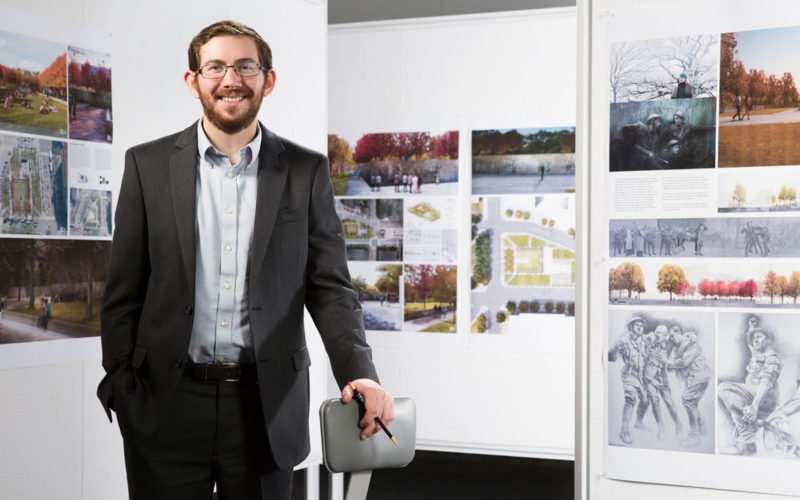BECCA MARTIN-BROWN
bmartin@nwadg.com

Photo by Russell Cothren courtesy University Relations
“Now that the design has come together, I’m heading back out to finish the last bit of fundraising,” architect Joe Weishaar says of his work on the World War I Memorial in Washington, D.C. “Things have been going immensely well the past year in securing the necessary funds to build the memorial, and I think we’re finally down to the last $10-$12 million. The sooner we have it all in hand, the sooner we can start construction.”
Born and raised in Fayetteville, Joe Weishaar remembers standing on the Champs Elysees in Paris as a University of Arkansas student and thinking, “What in the world is a kid from Arkansas doing here?” As it turned out, it was just a peek at the international limelight to come. Weishaar was only 25 when he was selected to design the national World War I Memorial in Washington, D.C.
Weishaar comes home April 3 to speak on “To End All Wars: The Fight for the National World War I Memorial” as part of the Honors College Invites lecture series at the UA. Here, he talks about his career thus far with What’s Up!
Q. What influenced your career choice? Was there a moment when you thought, ‘This is what I want to do’?
A. The moment I knew it was what I wanted to do must have come in the first 10-20 minutes of my first studio class [at the UA]. The professor walked into the room, told us to forget everything we thought we knew about buildings and made us to go buy five sheets of the biggest paper I had ever seen in my life. I can’t even describe how hooked I was from that point on, and I’ve never looked back.
Q. How did the World War I Memorial end up on your plate?
A. I think I came across the World War I Memorial competition at the end of May in 2015. I wasn’t even really looking for it; a link was just being hosted on one of the websites that I would visit for art and architecture ideas.
It would be entirely fair to say that up to this point in my life I knew close to zero about World War I. But I still clicked on the link. I cranked out a design in about three weeks, working after work and on weekends. Then I sent it off and completely forgot about it for the next two months.
On Aug. 17, I got a series of missed calls during a meeting. When I finally got around to calling back, everyone on the other end of the line wanted to make sure I was sitting down. Ten minutes later I was on a bus stop bench with my head between my knees taking very deep breaths. I was one of five finalists to design the memorial. I could go on at length about how hard the next four months were, but I think I’ll save all of that for a book one day. Long story short, I emerged in January of 2016 completely broke, living in a different apartment, dead tired and nearly out of a job, but I had won the competition.
I’ve been living in D.C. since May of 2016 to be better connected with the project.

Image courtesy UA
“The design has always been relatively simple and straightforward, even through its many iterations,” architect Joe Weishaar says of the World War I Memorial he’s designing in Washington, D.C. “Everything in the design needed to look and feel timeless to help the memorial feel relevant even in 200 years, so we’ve gone with materials that are very timeless themselves: bronze, granite, water, etc.”
Q. What did you learn about World War I that influenced your design?
A. I learned that the war was terrible. There have been many days in this process that I want to chuck the design out the window and just turn the memorial into a cautionary tale. A million empty helmets, or a field of mud that plays the cries of help from dying soldiers. But I can’t do that. It would be a horridly morbid thing that I doubt people would want to see. Maybe one day I’ll design it, but not here. This memorial is for the good and the bad. For every terrible story of the war that I come across, there’s one about female radio operators who saved the day or a lone soldier who defended his dying friends from the onslaught of the battle, to not honor those men and women for their service and sacrifice would be a discredit to their memories.
__
FAQ
Honors College Invites:
Joe Weishaar
WHEN — 6 p.m. April 3
WHERE — Gearhart Hall Auditorium at the University of Arkansas in Fayetteville
COST — Free
INFO — 575-7678, honorscollege.uark.edu/engage/honors-college-invites.php



